-
ARTÍCULO ORIGINAL04/12/2023
“Fala-M@no-COVID-19”: technological development of a health navigation program for men during the pandemic
Revista Brasileira de Enfermagem. 2023;76(6):e20220534
Resumen
ARTÍCULO ORIGINAL“Fala-M@no-COVID-19”: technological development of a health navigation program for men during the pandemic
Revista Brasileira de Enfermagem. 2023;76(6):e20220534
DOI 10.1590/0034-7167-2022-0534
Visualizações0Ver maisABSTRACT
Objective:
to develop a care-educational technology similar to a health navigation program for men during the COVID-19 pandemic.
Methods:
a methodological and qualitative study of a care-educational technology of health navigation program, structured by Program Development Cycle, with 16 patient navigators and 10 professional navigators. It used reflective thematic content analysis and an adaptation model for data processing.
Results:
the ; navigation program was developed by: I) Observation of reality, problem mapping, needs assessment: content selection, creation of domains and questions; II) Theoretical-conceptual and methodological definition, creation of product under the elaboration of care plans, based on theory, process and taxonomies by a flowchart of operationalization of actions; and III) Self-assessment: qualitative research with professional navigators.
Final considerations:
the technology developed, with theoretical and methodological support, allowed to derive a viable navigation program compatible with reality based on the audience’s needs.
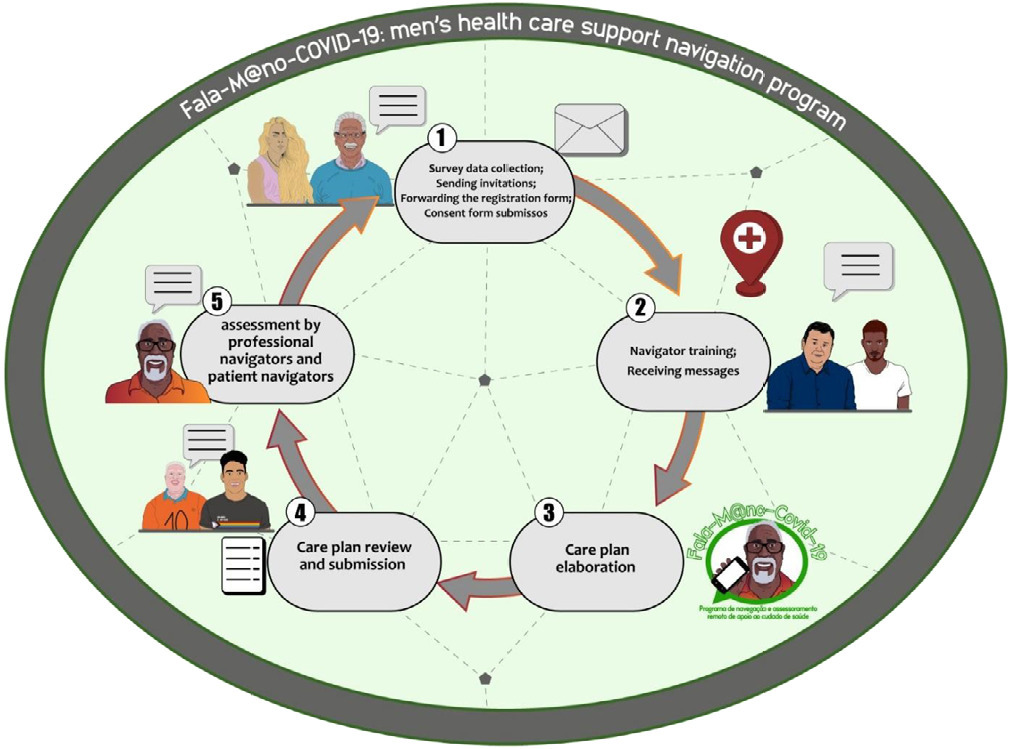
-
ARTÍCULO ORIGINAL04/12/2023
Social representation of young people in higher education about sexually transmitted infections
Revista Brasileira de Enfermagem. 2023;76(6):e20220406
Resumen
ARTÍCULO ORIGINALSocial representation of young people in higher education about sexually transmitted infections
Revista Brasileira de Enfermagem. 2023;76(6):e20220406
DOI 10.1590/0034-7167-2022-0406
Visualizações0Ver maisABSTRACT
Objective:
to analyze the social representations about sexually transmitted infections elaborated by undergraduate students.
Methods:
a descriptive, qualitative study, in the light of the structural approach of Social Representation Theory, carried out with 160 young undergraduate students, in the second half of 2019, in the city of Rio de Janeiro. Data were collected using a sociodemographic characterization questionnaire, knowledge and practices for preventing sexually transmitted infections, analyzed using descriptive statistics and a form of free evocations with the inducing term STD, analyzed using prototypical and similarity analysis.
Results:
the representation’s possible central nucleus is composed of lexicons aids, disease and HIV; the peripheral system by syphilis, sex, condoms, gonorrhea, prevention, infection, carelessness, HPV, herpes, ignorance, treatment, fear, unprotected-sex and danger.
Final considerations:
social thinking about sexually transmitted infections is characterized by their recognition as diseases, which require barrier prevention measures, associating with unsafe sexual practices that arouse fear.
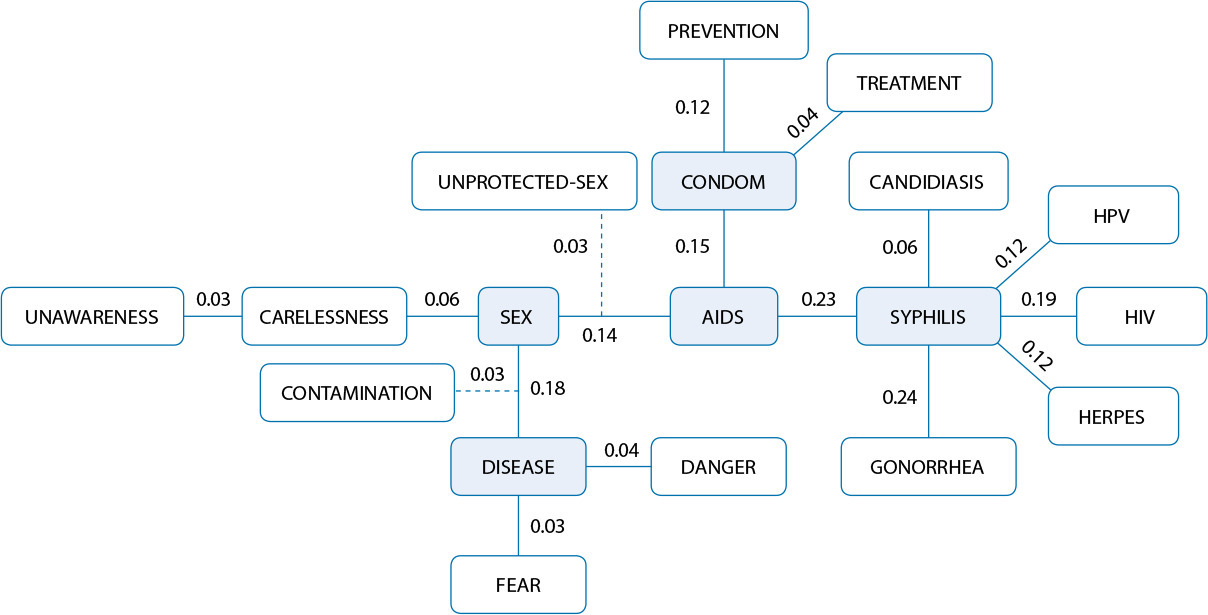
-
04/12/2023
The Medical Healing of Souls: a strategy for welcoming post-pandemic mental health
Revista Brasileira de Enfermagem. 2023;76(6):e20220331
Resumen
The Medical Healing of Souls: a strategy for welcoming post-pandemic mental health
Revista Brasileira de Enfermagem. 2023;76(6):e20220331
DOI 10.1590/0034-7167-2022-0331
Visualizações0Ver maisABSTRACT
Objective:
to reflect on the applicability of the Medical Healing of Souls (MHS) by health professionals as a welcoming strategy in post-pandemic mental health.
Methods:
a theoretical and reflective study, based on Viktor Frankl’s philosophy, based on the book “The Doctor and the Soul, From Psychotherapy to Logotherapy” and scientific literature.
Results:
the study was structured in two discursive approaches: MHS in the field of health; The applicability of MHS in post-pandemic mental health care.
Final considerations:
MHS can be used in mental health care, in health emergencies, promoting a more humane performance of health professionals, facilitating the integration of inevitable suffering into a meaningful life.
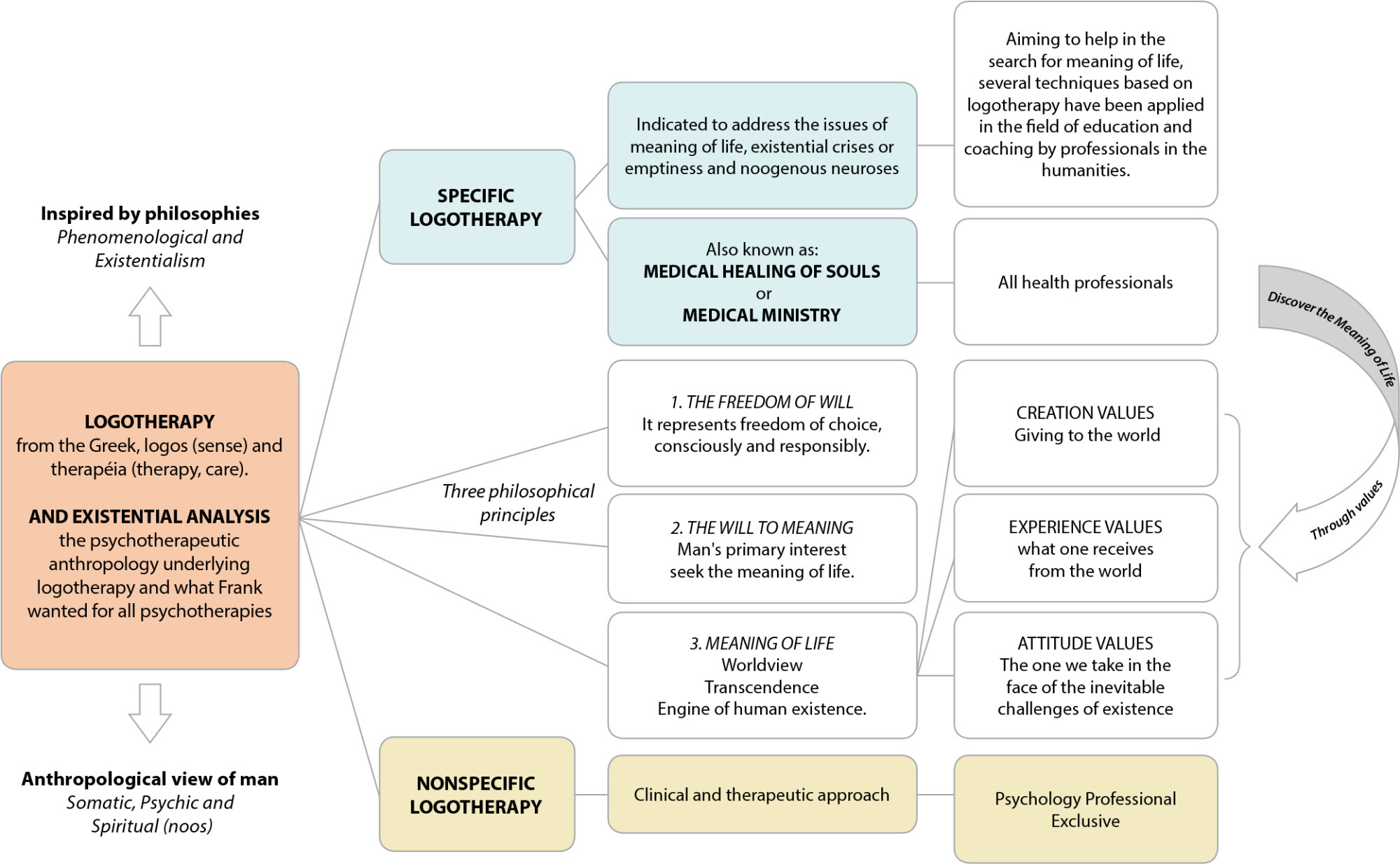
-
ARTÍCULO ORIGINAL04/12/2023
Translation, cross-cultural adaptation and validity study of the “Play Nicely Program: The Healthy Discipline Handbook” for use in Brazil
Revista Brasileira de Enfermagem. 2023;76(6):e20220281
Resumen
ARTÍCULO ORIGINALTranslation, cross-cultural adaptation and validity study of the “Play Nicely Program: The Healthy Discipline Handbook” for use in Brazil
Revista Brasileira de Enfermagem. 2023;76(6):e20220281
DOI 10.1590/0034-7167-2022-0281
Visualizações0Ver maisABSTRACT
Objective:
to describe the translation, cross-cultural adaptation and validity process of the “Play Nicely Program: The Healthy Discipline Handbook” for use in Brazil.
Methods:
a methodological study that followed the translation, back-translation, expert committee assessment, and pre-test steps. The Content Validity Index (CVI) was calculated for both the judge population and the pre-test population. Four translators, seven expert judges in the field of child health and thirty participants in the pre-test, including parents, teachers and healthcare professionals, participated in the study.
Results:
in experts’ analysis (98.4%), a value of 100% of adequate assessments was obtained, and in the target population’s analysis (89.5%), there were 100% of adequate assessments. In both analyses, suggested adaptations were made.
Conclusios:
cross-cultural adaptation and content validity into Brazilian Portuguese of the “Play Nicely Program: The Healthy Discipline Handbook” were considered adequate for application in the target population.
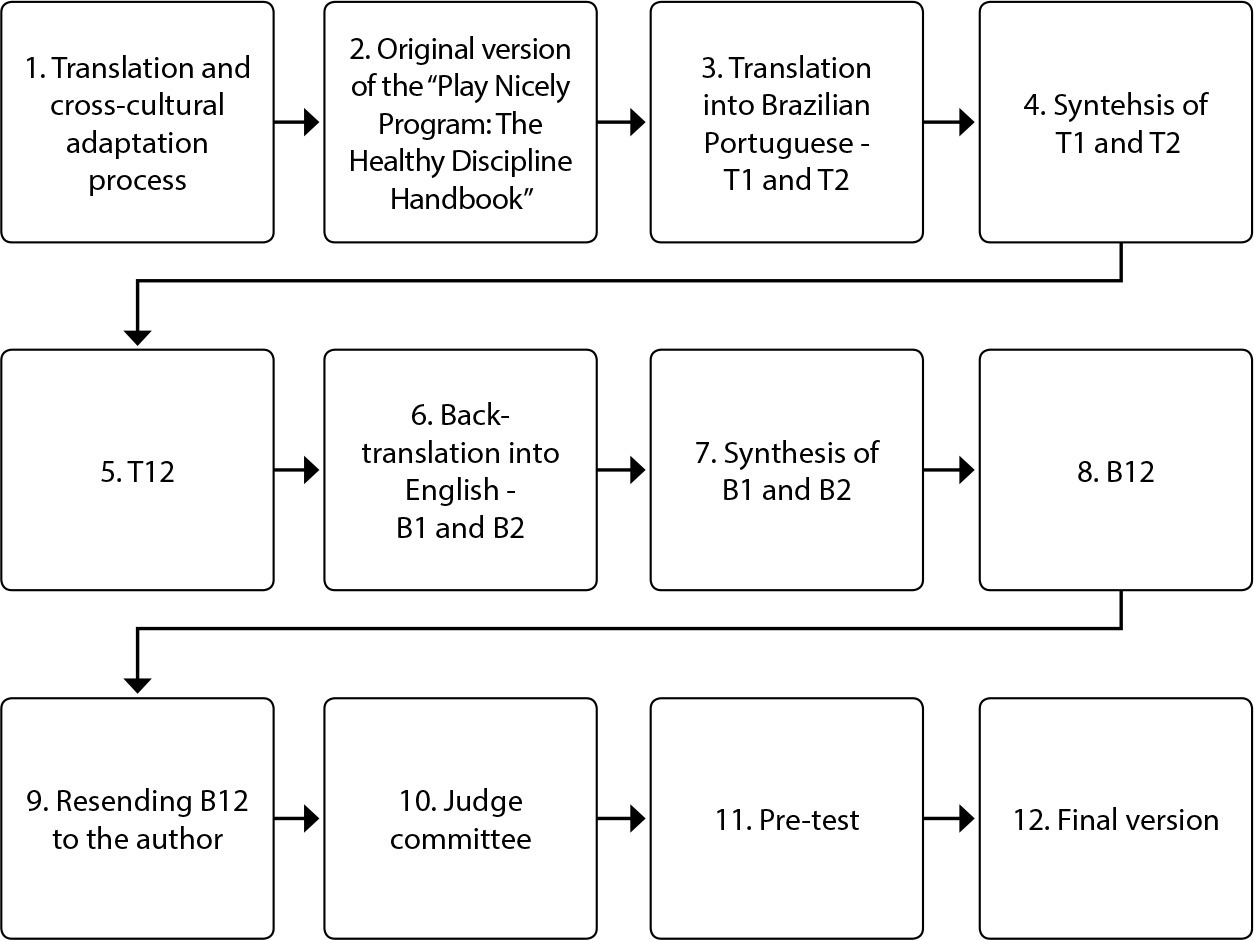
-
ARTÍCULO ORIGINAL04/12/2023
Assessment of the components of sarcopenia and quality of life perceived of individuals on hemodialysis
Revista Brasileira de Enfermagem. 2023;76(6):e20220677
Resumen
ARTÍCULO ORIGINALAssessment of the components of sarcopenia and quality of life perceived of individuals on hemodialysis
Revista Brasileira de Enfermagem. 2023;76(6):e20220677
DOI 10.1590/0034-7167-2022-0677
Visualizações1Ver maisABSTRACT
Objectives:
to evaluate the prevalence of sarcopenia in individuals aged 50 years or older on hemodialysis; to verify the association between sarcopenia and sociodemographic, clinical, anthropometric factors, components of sarcopenia and quality of life (QoL); and to correlate the components of sarcopenia with QoL.
Methods:
Participated 83 individuals on hemodialysis. Sarcopenia was established according to the current European consensus. Dynamometry to determine strength, calf circumference (CC) and appendicular skeletal muscle mass index (ASMMI) to obtain muscle mass and gait speed (GS) for physical performance. For QoL used the WHOQOL-bref.
Results:
the prevalence of sarcopenia was 32.6% (CC) and 18.1% (ASMMI). There was no association between sarcopenia and QoL. Both handgrip strength (r=0.25) and GS (r=0.36) showed a correlation with physical domain.
Conclusions:
sarcopenia was expressive, and the aspects of functionality determine the physical impairment in this population.
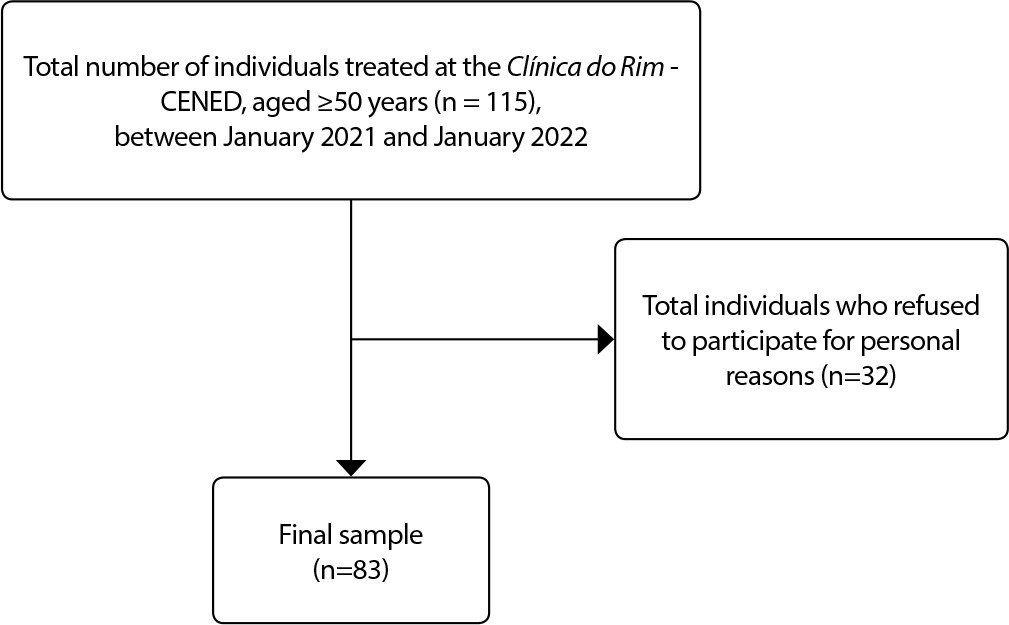
-
ARTÍCULO ORIGINAL04/12/2023
Efectos de la auriculoterapia sobre la ansiedad y biomarcadores en Atención Primaria de Salud: un ensayo clínico
Revista Brasileira de Enfermagem. 2023;76(6):e20220728
Resumen
ARTÍCULO ORIGINALEfectos de la auriculoterapia sobre la ansiedad y biomarcadores en Atención Primaria de Salud: un ensayo clínico
Revista Brasileira de Enfermagem. 2023;76(6):e20220728
DOI 10.1590/0034-7167-2022-0728pt
Visualizações0RESUMEN
Objetivo:
evaluar los efectos de la auriculoterapia sobre la ansiedad y los niveles séricos de factor neurotrófico derivado de cerebro (BDNF), enolasa-específica de neurona (NSE) y proteína fijadora de calcio S100B (S100B) en adultos atendidos en Atención Primaria de Salud.
Métodos:
ensayo clínico piloto preexperimental. Se obtuvo información de 19 pacientes mediante el Inventario de Ansiedad Estado-Rasgo (STAI) y análisis de niveles séricos de BDNF, NSE y S100B.
Resultados:
la puntuación de ansiedad preintervención en el IDATE-Rasgo fue de 52,11±6,691 (CV 12,84%) y la valoración tras la auriculoterapia fue significativamente menor (43,72±8,141; CV 18,62%; P=0,0007). Los niveles de S100B se redujeron significativamente después de la auriculoterapia (de 64,03±72,18 a 54,03±68,53 pg/mL; CV 126,8%; P=0,0023).
Conclusión:
la auriculoterapia redujo efectivamente los niveles de ansiedad. Demostró ser seguro y fácil de aplicar, lo que permitió a las enfermeras realizar esta técnica de forma autónoma. También se evidenció una reducción de S100B, lo que demuestra una posible prevención del daño neuronal.
Palavras-chave: AnsiedadAtención Primaria de SaludAuriculoterapiaBiomarcadoresEvaluación en EnfermeríaVer mais -
ARTÍCULO ORIGINAL04/12/2023
Leadership Competencies of the Medical-Surgical Nursing Specialist Nurse
Revista Brasileira de Enfermagem. 2023;76(6):e20220721
Resumen
ARTÍCULO ORIGINALLeadership Competencies of the Medical-Surgical Nursing Specialist Nurse
Revista Brasileira de Enfermagem. 2023;76(6):e20220721
DOI 10.1590/0034-7167-2022-0721
Visualizações0Ver maisABSTRACT
Objective:
To identify the leadership competencies of Medical-Surgical Nursing Specialist Nurses.
Methods:
A quantitative, descriptive study using the Leadership Competencies Questionnaire. 311 Portuguese Medical-Surgical Nursing Specialist Nurses participated. Data analysis involved descriptive and inferential statistical analysis using the Statistical Package for Social Sciences (SPSS), version 22.0.
Results:
Study participants had an above-average self-perception on the scale (mean = 3.5) in all leadership roles, recognizing their leadership competencies. The leadership competencies of Medical-Surgical Nursing Specialist Nurses are balanced across all roles: Mentor (5.80 ± 1.02); Coordinator (5.53 ± 0.86); Facilitator (5.38 ± 1.04); Innovator (5.34 ± 0.88); Director (5.31 ± 1.10); Producer (5.30 ± 0.98); Monitor (5.15 ± 1.00); Corrector (4.79 ± 1.29)
Conclusions:
Specialized nursing practice enhances nurses’ self-perceived leadership competencies. Nurses see themselves as leaders focused on internal support and facilitation of collective effort and opportunities for skill development.
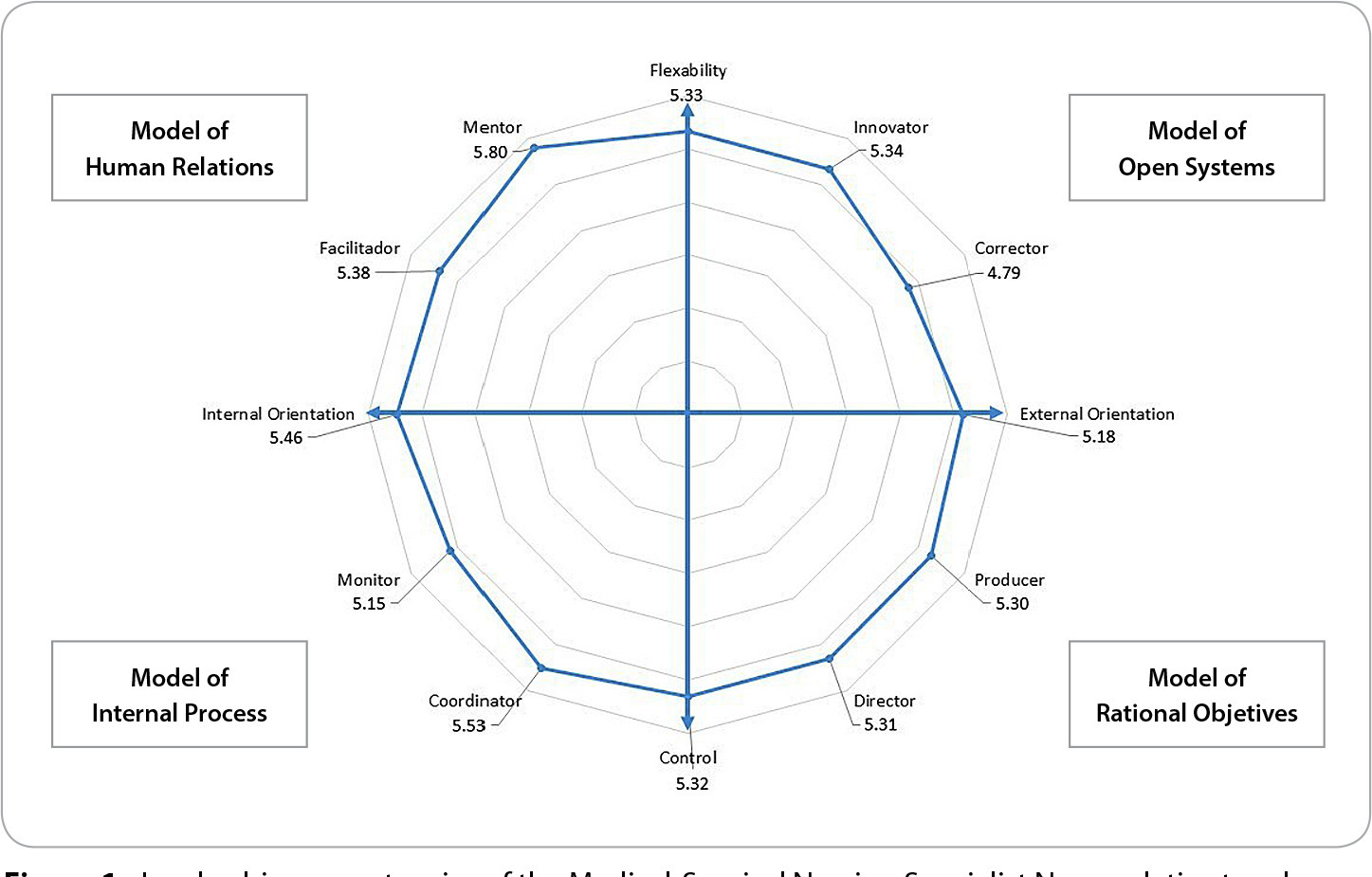
-
ARTÍCULO ORIGINAL04/12/2023
Feelings about birth by a group of high-risk pregnant women
Revista Brasileira de Enfermagem. 2023;76(6):e20230059
Resumen
ARTÍCULO ORIGINALFeelings about birth by a group of high-risk pregnant women
Revista Brasileira de Enfermagem. 2023;76(6):e20230059
DOI 10.1590/0034-7167-2023-0059
Visualizações0Ver maisABSTRACT
Objective:
to understand feelings about birth among a group of high-risk pregnant women.
Method:
a descriptive and qualitative study, using Alfred Schütz’s social phenomenology as a philosophical theoretical framework. The study included 25 pregnant women undergoing high-risk prenatal care. The interview had the following guiding questions: tell me about your feelings regarding the moment of birth/childbirth; How do you deal with the high-risk diagnosis? What are your expectations for birth/childbirth?
Results:
five categories emerged: Fear of obstetric care; Fear of complications with the baby; Fear of cesarean section; Resilience in the face of high-risk pregnancy; and Expectations for birth.
Considerations:
high-risk pregnant women are afraid of the care they will receive, the risks and concern about the baby’s vitality at birth. The importance of care is emphasized, with a welcoming environment, bonding and communication between health team and pregnant woman.
-
ARTÍCULO ORIGINAL13/07/2020
Cultura de segurança do paciente em unidades hospitalares de ginecologia e obstetrícia: estudo transversal
Revista Brasileira de Enfermagem. 2020;73(5):e20190576
Resumen
ARTÍCULO ORIGINALCultura de segurança do paciente em unidades hospitalares de ginecologia e obstetrícia: estudo transversal
Revista Brasileira de Enfermagem. 2020;73(5):e20190576
DOI 10.1590/0034-7167-2019-0576
Visualizações1RESUMO
Objetivos:
avaliar a cultura de segurança do paciente da equipe de saúde que atua em três maternidades.
Métodos:
estudo observacional, transversal, comparativo. Participaram do estudo 301 profissionais. Utilizou-se o questionário Hospital Survey on Patient Safety Culture validado no Brasil. Para a análise dos dados, considerou-se área forte na cultura de segurança do paciente quando as respostas positivas atingiram acima de 75%; e áreas que precisam de melhorias quando as respostas positivas atingiram menos de 50%. Para a comparação dos resultados, empregou-se desvio-padrão e regra do polegar.
Resultados:
das 12 dimensões da cultura de segurança do paciente, nenhuma obteve escore acima de 75%, sendo nove dimensões com escore entre 19% e 43% e três dimensões entre 55% e 57%.
Conclusões:
não foram identificadas dimensões fortes para cultura de segurança nas três maternidades. Acredita-se que esses resultados possam contribuir na elaboração de políticas que promovam a cultura de segurança nas instituições.
Palavras-chave: Cultura OrganizacionalEquipe de Assistência ao PacienteEstudos TransversaisSegurança do PacienteUnidade Hospitalar de Ginecologia e ObstetríciaVer mais -
ARTÍCULO ORIGINAL21/09/2020
Autonomia na saúde reprodutiva de mulheres quilombolas e fatores associados
Revista Brasileira de Enfermagem. 2020;73:e20190786
Resumen
ARTÍCULO ORIGINALAutonomia na saúde reprodutiva de mulheres quilombolas e fatores associados
Revista Brasileira de Enfermagem. 2020;73:e20190786
DOI 10.1590/0034-7167-2019-0786
Visualizações0RESUMO
Objetivo:
Identificar o nível de autonomia reprodutiva de mulheres quilombolas e associá-lo com características sociodemográficas e aspectos da saúde sexual e reprodutiva.
Métodos:
Estudo censitário transversal realizado em comunidades quilombolas de um município baiano. Os dados foram coletados por meio dos questionários da Pesquisa Nacional de Saúde e da Escala de Autonomia Reprodutiva, aplicados às mulheres quilombolas que aceitaram participar. Utilizaram-se procedimentos da estatística descritiva e realizaram-se associações entre os escores de autonomia reprodutiva e as características sociodemográficas e reprodutivas.
Resultados:
O escore médio total de autonomia reprodutiva foi 2,06. Verificou-se associação entre o escore de “tomada de decisão” e estado conjugal. O escore de “autonomia reprodutiva total” foi associado à utilização de método contraceptivo.
Conclusão:
A realidade das participantes do estudo converge com a literatura quanto à interferência de fatores sociodemográficos e reprodutivos na autonomia reprodutiva de mulheres negras.
Palavras-chave: Autonomia PessoalFatores SocioeconômicosGrupo com Ancestrais do Continente AfricanoMulheresSaúde ReprodutivaVer mais -
ARTÍCULO ORIGINAL01/06/2020
Binge drinking and overweight in brazilian adults – CUME Project
Revista Brasileira de Enfermagem. 2020;73:e20190316
Resumen
ARTÍCULO ORIGINALBinge drinking and overweight in brazilian adults – CUME Project
Revista Brasileira de Enfermagem. 2020;73:e20190316
DOI 10.1590/0034-7167-2019-0316
Visualizações0Ver maisABSTRACT
Objective:
To verify the association between heavy episodic alcohol consumption [binge drinking (BD)] and overweight in 2,909 adults from the Cohort of Universities of Minas Gerais (CUME Project) baseline, Brazil.
Method:
Cross-sectional study in which sociodemographic, anthropometric (BMI ≥ 25 kg/m2 = overweight) and dietary intake data were collected. This study evaluated the occurrence and monthly frequency of BD (≥ 4 drinks at one time for women; ≥ 5 drinks at one time for men, in the last 30 days).
Results:
The prevalence of BD and overweight were 41.3% and 40.8%, respectively. BD increased the prevalence of overweight by 19%, and, BD exposure by ≥ 5 days / month increased it by 31%.
Conclusion:
BD on a single or multiple occasion during the month was associated with a higher prevalence of overweight. Therefore, such a lifestyle should be considered in weight gain prevention strategies.
-
ARTÍCULO ORIGINAL07/04/2023
The use of toys by nursing as a therapeutic resource in the care of hospitalized children
Revista Brasileira de Enfermagem. 2023;76(2):e20220433
Resumen
ARTÍCULO ORIGINALThe use of toys by nursing as a therapeutic resource in the care of hospitalized children
Revista Brasileira de Enfermagem. 2023;76(2):e20220433
DOI 10.1590/0034-7167-2022-0433
Visualizações0Ver maisABSTRACT
Objectives:
to describe the use of toys by nursing during the care of children in the inpatient unit; to analyze the factors that influence the use of therapeutic toys by nursing in the care of hospitalized children.
Methods:
qualitative research, conducted in a pediatric hospital in Rio de Janeiro between July and August 2019. Semi-structured interview and thematic analysis were used as methodological procedure.
Results:
the 12 nurses and 7 nursing technicians revealed minimizing fear, relieving tension, and creating a bond between the child and the professional as the main benefits; they use as resources: children’s toys, hospital materials, cartoons, and children’s videos. The high demand for work, deficit of human resources, and appropriate ludic materials are factors that interfere with the use of toys as a therapeutic resource.
Final Considerations:
although the participants recognize the importance of the toy as a therapeutic resource, there is no systematization of its use in pediatric practice.
-
ARTÍCULO DE REVISIÓN29/09/2022
Cuidados paliativos na Atenção Primária à Saúde: revisão integrativa de literatura
Revista Brasileira de Enfermagem. 2022;75(1):e20201335
Resumen
ARTÍCULO DE REVISIÓNCuidados paliativos na Atenção Primária à Saúde: revisão integrativa de literatura
Revista Brasileira de Enfermagem. 2022;75(1):e20201335
DOI 10.1590/0034-7167-2020-1335
Visualizações0RESUMO
Objetivos:
analisar evidências cientificas sobre a implementação e realização dos cuidados paliativos na Atenção Primária à Saúde.
Métodos:
revisão integrativa da literatura, segundo o Preferred Reporting Items for Systematic Reviews and Meta-Analyses, realizada nas bases de dados PubMed, SciVerse Scopus e LILACS, em dezembro de 2020, sem recorte temporal.
Resultados:
foram analisados 22 artigos científicos originais, 14 classificados com nível de evidência VI. Objetivou-se compreender as experiências e os papéis de profissionais, pacientes e familiares sobre cuidados paliativos na Atenção Primária à Saúde, artigos voltados para a temática de gestão e organização dos serviços de saúde e sobre a importância de intervenções educativas na temática.
Considerações Finais:
evidências encontradas relacionando cuidados paliativos na Atenção Primária à Saúde apontam para a possibilidade desse cuidado; equipes de saúde atuam de maneira próxima a família e seu domicílio, porém ainda se percebe a necessidade de ampliação deste tema.
Palavras-chave: Atenção Primária à SaúdeCuidados PaliativosEnfermagemEstratégia Saúde da FamíliaRevisãoVer mais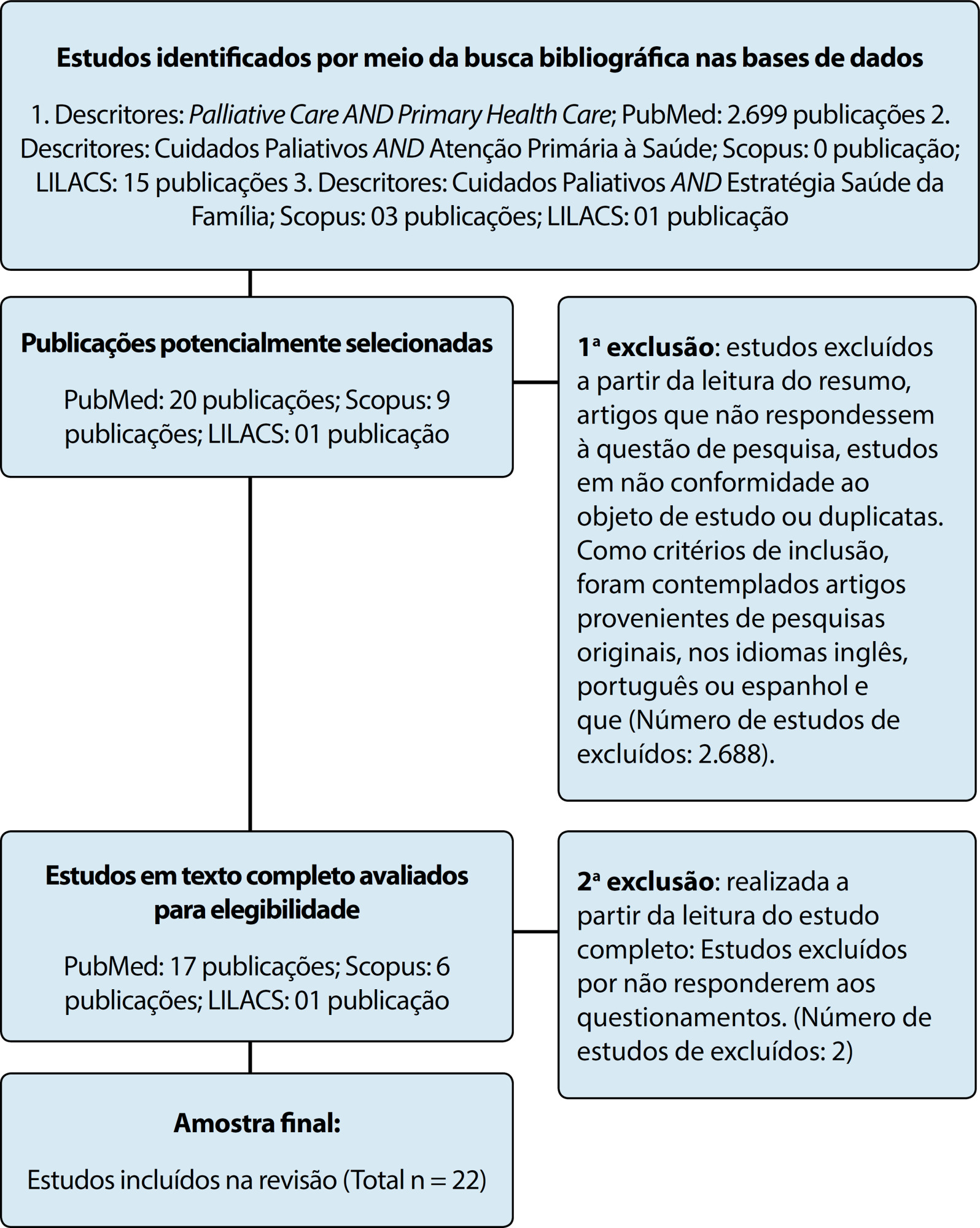
-
28/06/2021
Trends in fertility rates, proportion of antenatal consultations and caesarean sections among Brazilian adolescents
Revista Brasileira de Enfermagem. 2021;74:e20200884
Resumen
Trends in fertility rates, proportion of antenatal consultations and caesarean sections among Brazilian adolescents
Revista Brasileira de Enfermagem. 2021;74:e20200884
DOI 10.1590/0034-7167-2020-0884
Visualizações1Ver maisABSTRACT
Objective:
To analyze the temporal trends in the fertility rate, proportion of antenatal consultations and caesarean sections in Brazilian adolescents aged 15 to 19, between 2000 and 2015. Methods: The fertility rate, proportion of prenatal consultations and proportion of routes of birth were calculated using data from DATASUS. The trend analysis was performed using the Prais-Winsten regression model and the annual percentage change.
Results:
There was a trend of reduction of 3.5% per year in the fertility rate among adolescents (p<0.05), in addition to an increasing trend of 6% per year in the proportion of more than six antenatal consultations (p <0.0001) and an increasing trend of 6.8% per year in the proportion of caesarean sections (p<0.0001).
Conclusion:
Despite the decreasing trend in fertility rates among Brazilian adolescents, they remain high. Also noteworthy is the growing trend for caesarean sections, even with improved access to antenatal care.
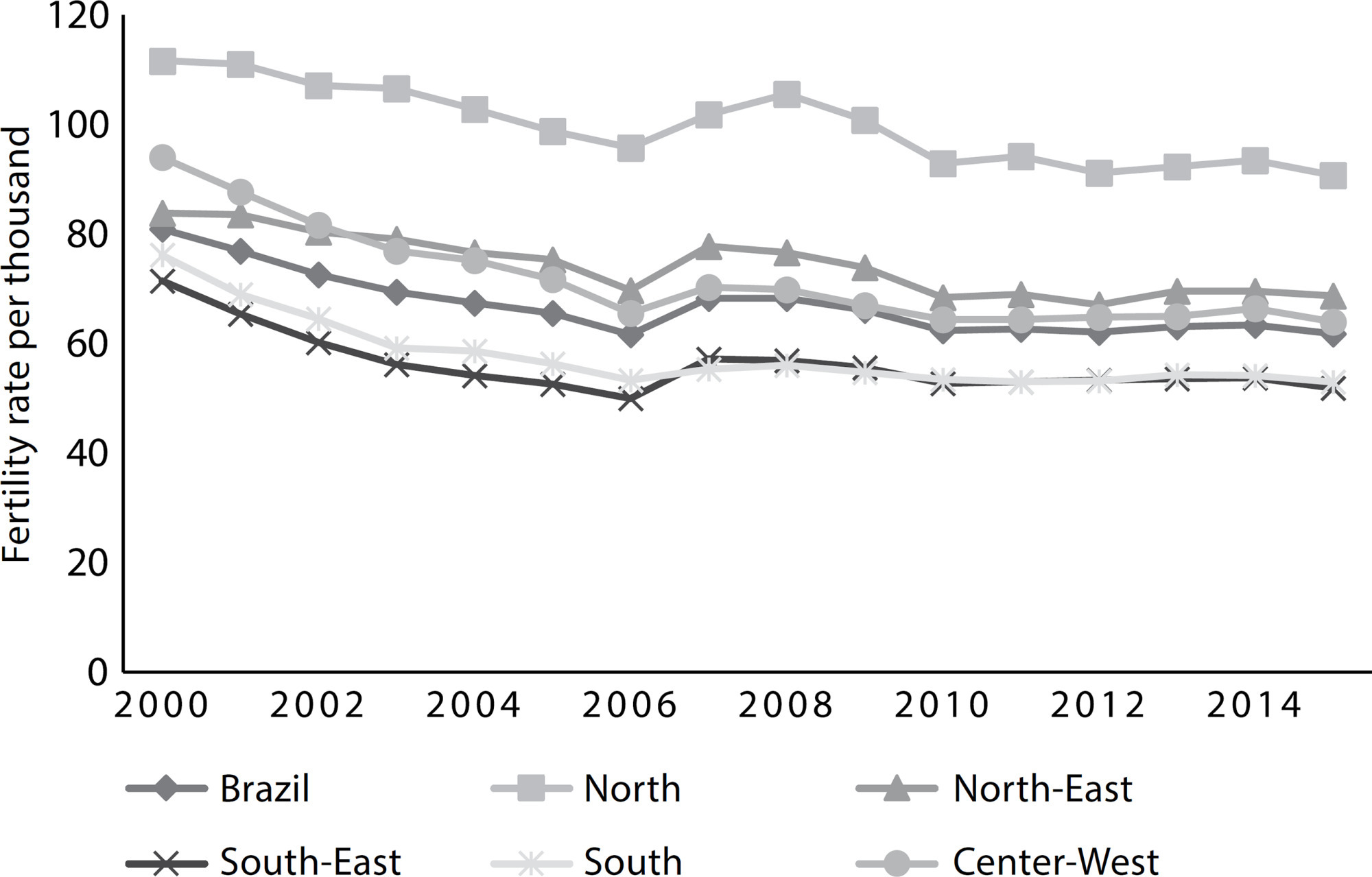
-
INFORME DE EXPERIENCIA13/11/2020
Pedagogical mediations for non-formal nursing teaching during the COVID-19 pandemic
Revista Brasileira de Enfermagem. 2020;73:e20200499
Resumen
INFORME DE EXPERIENCIAPedagogical mediations for non-formal nursing teaching during the COVID-19 pandemic
Revista Brasileira de Enfermagem. 2020;73:e20200499
DOI 10.1590/0034-7167-2020-0499
Visualizações0Ver maisABSTRACT
Objective:
to report the experience of developing pedagogical mediations in a Virtual Learning Environment implemented in a nursing faculty during the COVID-19 pandemic.
Methods:
an experience report on the construction of a distance course aimed at graduates and residents of a nursing faculty at a public university located in the city of Rio de Janeiro.
Results:
the course’s conception, operationalization and implementation were the result of a collective work that culminated in a non-formal, virtual and problematic teaching process, which reached a participation rate of 82% of enrolled students.
Final considerations:
even in times of social isolation, the course promoted collaborative learning of knowledge about COVID-19 and strengthened the relationship between professors and students. The possibility of carrying out distance activities based on solid methodological proposals that contradict the content logic often observed in distance learning is emphasized.
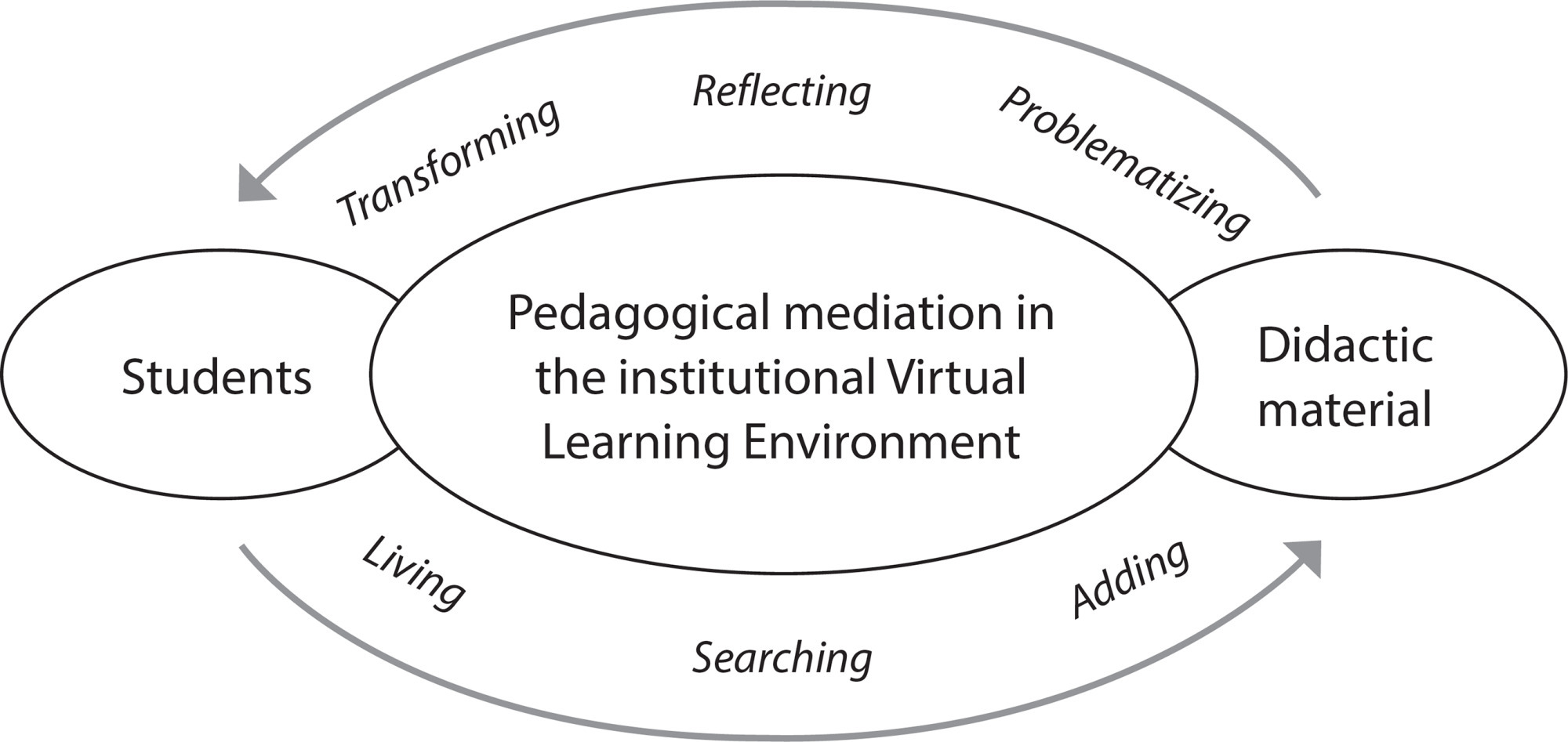
-
ARTÍCULO ORIGINAL01/06/2020
Condições de estrutura e processo na implantação do Sistema de Informação de Imunização do Brasil
Revista Brasileira de Enfermagem. 2020;73(4):e20180939
Resumen
ARTÍCULO ORIGINALCondições de estrutura e processo na implantação do Sistema de Informação de Imunização do Brasil
Revista Brasileira de Enfermagem. 2020;73(4):e20180939
DOI 10.1590/0034-7167-2018-0939
Visualizações0RESUMO
Objetivos:
analisar as condições estruturais e de processo na implantação do Sistema de Informação do Programa Nacional de Imunização.
Métodos:
estudo transversal realizado em 307 salas de vacinação em Minas Gerais em 2017. Para a coleta de dados, foi utilizado um questionário multidimensional. Procedeu-se a análise descritiva dos dados.
Resultados:
as salas de vacinação possuem insumos básicos necessários para a implantação do Sistema. Os maiores problemas relacionam-se às práticas dos profissionais. Identificaram-se baixo cadastro da população adscrita, falhas na busca ativa de faltosos, no aprazamento de vacinas e ausência de relatórios para monitorar a cobertura vacinal. As capacitações foram consideradas insuficientes e pouco efetivas.
Conclusões:
o Sistema de Informação de Imunização é uma inovação tecnológica essencial para o gerenciamento das ações de imunização, mas ainda são desafios a produção de registros oportunos e o uso da informação. Investimentos em capacitações são necessárias para garantir as atividades de gestão e operacionalização do Sistema.
Palavras-chave: EnfermagemEstudos de AvaliaçãoProgramas de ImunizaçãoSistema de Informação em SaúdeTecnologia de InformaçãoVer mais
Búsqueda
Buscar en:
Nuvem de Tags
Adolescente (85) Atenção Primária à Saúde (239) COVID-19 (91) Criança (91) Cuidados de Enfermagem (269) Educação em Enfermagem (151) Educação em Saúde (139) Enfermagem (930) Enfermagem Pediátrica (86) Estudantes de Enfermagem (77) Estudos de Validação (131) Família (87) Idoso (208) Promoção da Saúde (99) Qualidade de Vida (104) Saúde do Trabalhador (86) Saúde Mental (145) Saúde Pública (82) Segurança do Paciente (150) Tecnologia Educacional (100)



